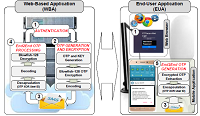Enhanced Multi-factor Out-of-Band Authentication En Route to Securing SMS-based OTP Ariel
Keywords:
Blowfish-128, eavesdropping, SMiShing, SMS-based OTPAbstract
Validation of user’s authenticity through authentication played a crucial role to address risks and security issues in today's connected world. Among different authentication methods, OTP sent via SMS was identified as the most commonly used multi-factor authentication mechanism. However, studies have shown that it has not remained attack-proof. It has been branded to be vulnerable to SMiShing, a technique comparable to Internet phishing, and Eavesdropping accomplished through keylogging, screens capturing, shoulder surfing and other social engineering practices. This study introduced an innovative approach to secure SMS-based OTP against its threats through OTP encryption using modified Blowfish algorithm. A mobile application was also employed for capturing and processing encrypted SMS-based OTP to produce new OTP for verification, thus performing end-to-end OTP. Experimentation results and analysis revealed that the proposed architecture was free against the said vulnerabilities and promote tighter security, making it a good alternative for SMS-based OTP multi-factor authentication.
References
P. Chandrakar and H. Om, "A secure and robust anonymous three-factor remote user authentication scheme for the multi-server environment using ECC," Computer Communications, vol. 110, pp. 26-34, 2017.
D. Dasgupta, A. Roy, and A. Nag, "Toward the design of adaptive selection strategies for multi-factor authentication," Computers & Security, vol. 63, pp. 85-116, 2016.
M. H. Barkadehi, M. Nilashi, O. Ibrahim, F. A. Zakeri, and S. Samad, "Authentication systems: a literature review and classification," Telematics and Informatics, vol. 35, pp. 1491-1511, 2018.
M. Belk, C. Fidas, P. Germanakos, and G. Samaras, "The interplay between humans, technology and user authentication: a cognitive processing perspective," Computers in Human Behavior, vol. 76, pp. 184-200, 2017.
J.- J. Huang, W.-S. Juang, C.-I. Fan, Y.-F. Tseng, and H. Kikuchi, "Lightweight authentication scheme with dynamic group members in IoT environments," in 13th International Conference on Mobile and Ubiquitous Systems: Computing Networking and Services, New York, NY, USA, 2016, pp. 88-93.
M. Gerami and S. Ghiasvand, "One-time passwords via SMS," Bulletin de la Société Royale des Sciences de Liège, vol. 85, pp. 106-113, 2016.
H. Siadati, T. Nguyen, P. Gupta, M. Jakobsson, and N. Memon, "Mind your SMSes: mitigating social engineering in second-factor authentication," Computers & Security, vol. 65, pp. 14-28, 2017.
A. R. L. Reyes, E. D. Festijo, and R. P. Medina, "Securing one time password (OTP) for multi-factor out-of-band authentication through a 128-bit blowfish algorithm," International Journal of Communication Networks and Information Security, vol. 10, pp. 242-247, 2018.
Y. Yu, J. He, N. Zhu, F. Cai, and M. S. Pathan, "A new method for identity authentication using mobile terminals," Procedia Computer Science, vol. 131, pp. 771-778, 2018.
M. Balduzzi, P. Gupta, L. Gu, D. Gao, and M. Ahamad, "MobiPot: understanding mobile telephony threats with honey cards," in 11th ACM on Asia Conference on Computer and Communications Security, New York, NY, USA, 2016, pp. 723-734.
E. Sediyono, K. I. Santoso, and Suhartono, "Secure login by using one-time password authentication based on MD5 hash encrypted SMS," in International Conference on Advances in Computing, Communications and Informatics, Mysore, India, 2013, pp. 1604-1608.
I. Velásquez, A. Caro, and A. Rodríguez, "Authentication schemes and methods: a systematic literature review," Information and Software Technology, vol. 94, pp. 30-37, 2018.
C. Shen, Y. Chen, and X. Guan, "Performance evaluation of implicit smartphones authentication via sensor-behavior analysis," Information Sciences, vol. 430–431, pp. 538-553, 2018.
A. S. Chaudhari, "Security analysis of SMS and related technologies," in Master's Thesis, Department of Mathematics and Computer Science, Eindhoven University of Technology, 2015.
D. Yadav, D. Malwe, K. S. Rao, P. Kumari, P. Yadav, and P. Deshmukh, "Intensify the security of one time password using elliptic curve cryptography with fingerprint for e-commerce application," International Journal of Engineering Science and Computing, vol. 7, pp. 5480-5482, 2017.
D. Zhao and W. Luo, "One-time password authentication scheme based on the negative database," International Journal of Engineering Science and Computing, vol. 7, pp. 5480-5482, 2017.
A. R. L. Reyes, E. D. Festijo, and R. P. Medina, "Blowfish-128: a modified blowfish algorithm that supports 128-bit block size," in 8th International Workshop on Computer Science and Engineering, Bangkok, Thailand, 2018, pp. 578-584.
S. E. S. Taba, I. Keivanloo, Y. Zou, and S. Wang, "An exploratory study on the usage of common interface elements in android applications," Journal of Systems and Software, vol. 131, pp. 491-504, 2017.
L. Wei, Y. Liu, and S.-C. Cheung, "Taming android fragmentation: characterizing and detecting compatibility issues for android apps," in 31st IEEE/ACM International Conference on Automated Software Engineering, Singapore, Singapore, 2016, pp. 226-237.
Password checker online. Available: http://password-checker.online-domain-tools.com
CrackStation - online password hash cracking - MD5, SHA1, Linux, rainbow tables, etc. Available: https://crackstation.net/

Published
How to Cite
Issue
Section
License
Copyright Notice
Submission of a manuscript implies: that the work described has not been published before that it is not under consideration for publication elsewhere; that if and when the manuscript is accepted for publication. Authors can retain copyright in their articles with no restrictions. Also, author can post the final, peer-reviewed manuscript version (postprint) to any repository or website.

Since Jan. 01, 2019, IJETI will publish new articles with Creative Commons Attribution Non-Commercial License, under Creative Commons Attribution Non-Commercial 4.0 International (CC BY-NC 4.0) License.
The Creative Commons Attribution Non-Commercial (CC-BY-NC) License permits use, distribution and reproduction in any medium, provided the original work is properly cited and is not used for commercial purposes.



.jpg)


